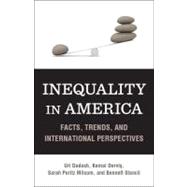Inequality in America Facts, Trends, and International Perspectives
, by Dadush, Uri; Dervis, Kemal; Milsom, Sarah P.- ISBN: 9780815724216 | 0815724217
- Cover: Paperback
- Copyright: 7/13/2012
Income inequality has been on the rise since the late 1970s, but the economic and financial crisis of 2008 instigated an unemployment epidemic that dramatically compounded this problem in the United States and catapulted the issue to the center ofdebate. There is wide agreement across the political spectrum that high inequality is contributing to undesirable circumstances such as stagnated median household income, rising poverty rates, and increased borrowing and debt; though there is much less agreement on remedies. Inequality in Americaprovides a snapshot of the issues posed by growing economic disparity, focusing particularly on America but drawing on international comparisons to help set the context. The authors examine the economic, technological, and political drivers of inequality as well as identify worrying trends associated with its rise, making the issues surrounding income distribution accessible to a wider public. The authors, each affiliated with Brookings or the Carnegie Endowment for International Peace, demonstrate how specific factors have exacerbated income inequality, including technological change, international trade, changes in labor market participation, and the increasing role of the financial sector. "Tackling the worst effects of inequality and reestablishing a measure of equal opportunity requires increased investment in crucial public goods, beginning with education, a more progressive and simplified tax system, and increased international cooperation to avoid a race to the bottom. Such policies are pursued by other high-performing advanced countries and can be shaped in a way that is fully consistentwith an efficient and competitive American economy." Contents 1. Introduction 2. The Increase of Inequality in the United States 3. Three Other Worrying Trends Associated with Rising Inequality 4. The Causes of Rising Inequality 5. Policy, Politics, and Inequality 6. What Can Be Done? 7. Concluding Remarks






